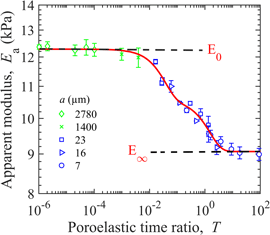Crossref Citations
This article has been cited by the following publications. This list is generated based on data provided by
Crossref.
Rausch, Manuel K.
Parekh, Sapun H.
Dortdivanlioglu, Berkin
and
Rosales, Adrianne M.
2021.
Synthetic hydrogels as blood clot mimicking wound healing materials .
Progress in Biomedical Engineering,
Vol. 3,
Issue. 4,
p.
042006.
Liu, Ming
and
Huang, Haiying
2021.
Poroelastic response of spherical indentation into a half space with an impermeable surface via step displacement.
Journal of the Mechanics and Physics of Solids,
Vol. 155,
Issue. ,
p.
104546.
Ramachandran, Tayaallen
Faruque, Mohammad Rashed Iqbal
and
Islam, Mohammad Tariqul
2021.
Symmetric square shaped metamaterial structure with quintuple resonance frequencies for S, C, X and Ku band applications.
Scientific Reports,
Vol. 11,
Issue. 1,
Hasan, Md Mahmudul
Johnson, Christopher L.
and
Dunn, Alison C.
2022.
Soft Contact Mechanics with Gradient-Stiffness Surfaces.
Langmuir,
Vol. 38,
Issue. 31,
p.
9454.
Richbourg, Nathan R.
Rausch, Manuel K.
and
Peppas, Nicholas A.
2022.
Cross-evaluation of stiffness measurement methods for hydrogels.
Polymer,
Vol. 258,
Issue. ,
p.
125316.
Xu, Dichu
Harvey, Terence
Begiristain, Eider
Domínguez, Cristina
Sánchez-Abella, Laura
Browne, Martin
and
Cook, Richard B.
2022.
Measuring the elastic modulus of soft biomaterials using nanoindentation.
Journal of the Mechanical Behavior of Biomedical Materials,
Vol. 133,
Issue. ,
p.
105329.
Shan, Yan
Zhang, Qiang
and
Yang, Qingsheng
2023.
Characterizing the Relaxation Behavior of Double-Network Hydrogels under Large Deformation by Indentation Test.
Mechanics of Solids,
Vol. 58,
Issue. 3,
p.
890.
Xu, Dichu
Hernandez Miranda, Maria Luisa
Evans, Nicholas D.
Sengers, Bram G.
Browne, Martin
and
Cook, Richard B.
2023.
Depth profiling via nanoindentation for characterisation of the elastic modulus and hydraulic properties of thin hydrogel layers.
Journal of the Mechanical Behavior of Biomedical Materials,
Vol. 148,
Issue. ,
p.
106195.
Zhang, Tiansheng
Liu, Ming
and
Huang, Haiying
2024.
Numerical analysis of the indentation of a poro-elastoplastic half space by a rigid cylinder.
IOP Conference Series: Earth and Environmental Science,
Vol. 1331,
Issue. 1,
p.
012001.
Liu, Ming
and
Huang, Haiying
2024.
Master Curves for Poroelastic Spherical Indentation With Step Displacement Loading.
Journal of Applied Mechanics,
Vol. 91,
Issue. 10,
Reinhards – Hervás, C.
Rodríguez, J.
and
Rico, A.
2025.
Poroviscoelastic characterization of polyacrylamide–alginate hydrogels across a broad range of length scales using torsional and depth sensing indentation tests.
Polymer Testing,
Vol. 153,
Issue. ,
p.
109015.
Feng, Xue
Yingxiong, Leng
Xiaoji, Guo
Haobo, Liang
and
Caihong, Dong
2025.
Wave propagation phenomenon of poroelastic piezoelectric micro-fan actuators for power equipment detection.
Acta Mechanica,
Vol. 236,
Issue. 7,
p.
4025.
Asamoah, Seth
Pravda, Martin
Šnejdrová, Eva
Čepa, Martin
Jiří, Mrázek
Gruber‐Traub, Carmen
and
Velebný, Vladimír
2025.
Photocrosslinked Mucoadhesive Hyaluronic Acid Hydrogel for Transmucosal Drug Delivery.
Journal of Biomedical Materials Research Part B: Applied Biomaterials,
Vol. 113,
Issue. 9,



